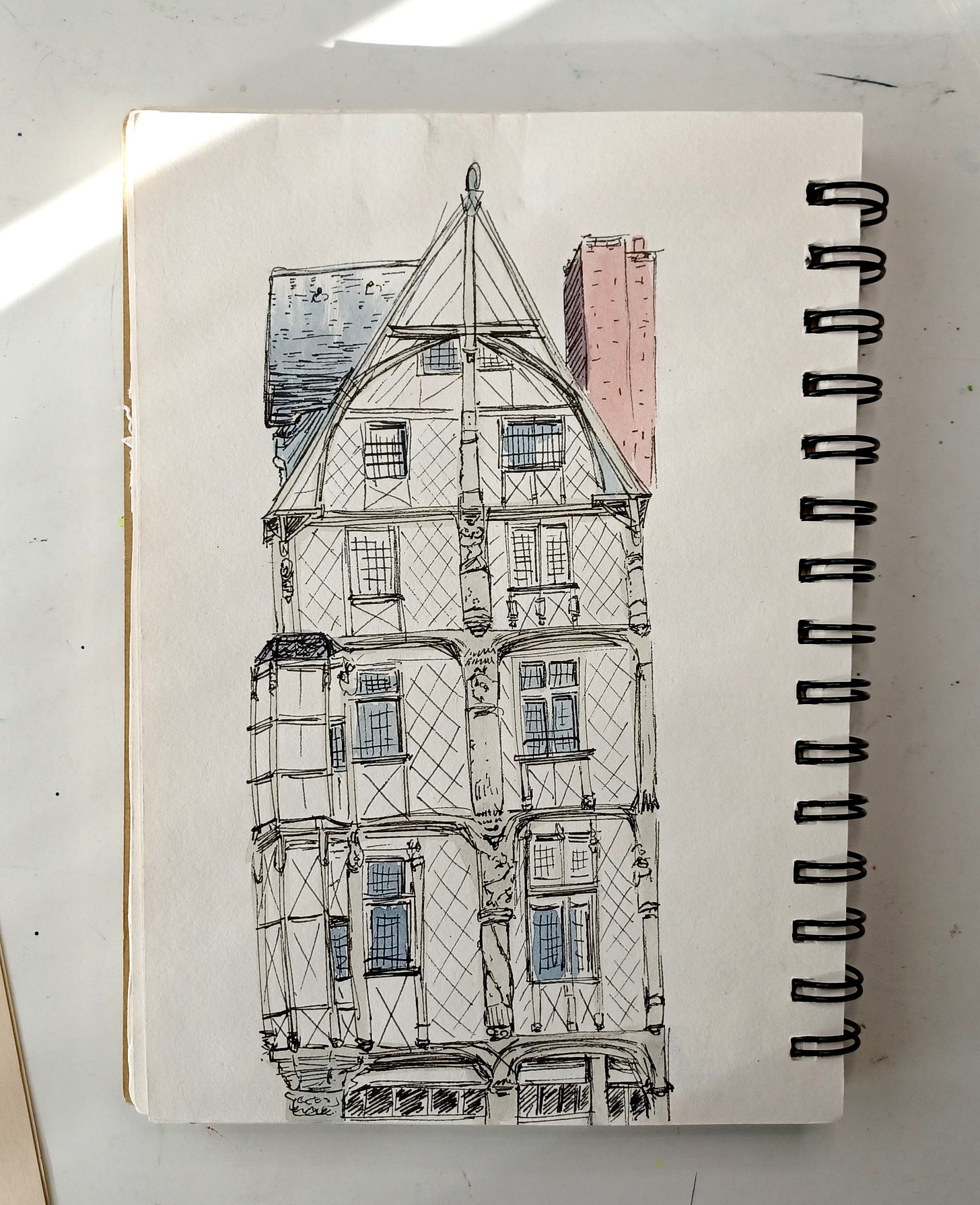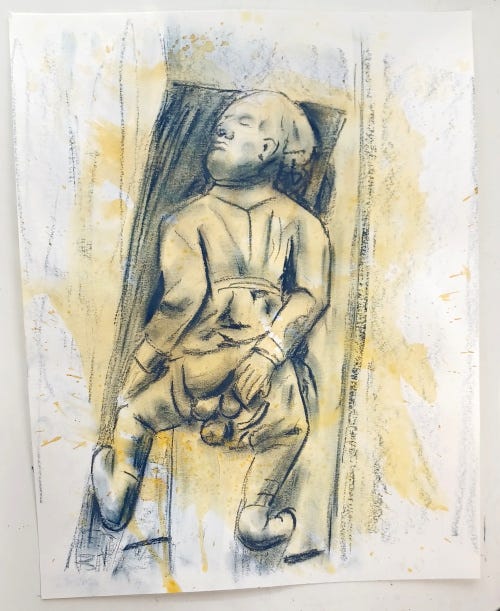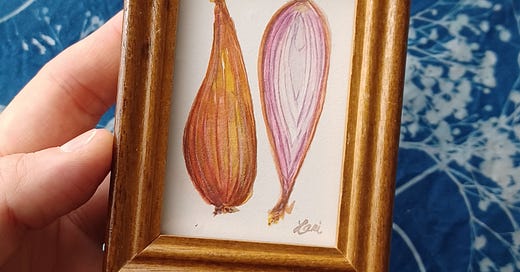RENDERED 30: La Gouline Angevine, or The Flavor of Culinary Gentrification
Gastronationalism baked into a pie
Welcome back to RENDERED! This month, I’m talking about the French city I know best: Angers.
Angers is a mid-size city located in a region historically called Anjou, in the Pays de la Loire region of western France. This is wine country, baby: think Saumur, Savennières, Chenin, Coteaux du Layon. The digestive liqueurs Cointreau and Menthe-Pastille are made here, too. Angers is France’s greenest city, and large murals decorate building facades, making city strolls rather pleasant. I just had my 10-year anniversary of moving here to Anjou, so let me introduce you to my city, beyond what’s written in tourism guides.

It is early 2022, in the City Hall of Angers, France.
I’m one-third of a delegation of volunteers that have come for an audience with the Mayor. We’re in an austere meeting room, where one wall is plastered with an enormous map of the city. Gesturing excitedly in front of it is then-Mayor (now a Minister in Macron’s government), explaining his vision for the renewal of a low-income neighborhood. He arrived very late, and whirlwinded right into his schpiel.
Nevermind that we hadn’t come to discuss that project at all–we were there to argue against the closure of the Municipal Institute.
The Institute is a continuing-learning center, open to all members of the public for reasonable rates–think computer classes for seniors, French classes for foreign residents, adult literacy classes, and language courses. I have been studying Spanish there for years, and was shocked to find out that the city decided to retake the building, with no future plans for the Institute.
So in response, we created a collective. Hundreds of people wrote in support, assemblies were held, delegates were chosen, and city officials were directly confronted–they didn’t expect that much backlash for booting the Institute in the name of progress.
But it’s the one place in our city that makes adult education accessible, regardless of age, class, or nationality. It deserves to be in the city center, where it is accessible to all.
Angers is among France’s most economically-segregated cities, and the city center is prime real estate. Housing costs are swelling, and more and more landlords are listing their places on AirBnb. So like many other cities, a housing crisis is emerging. 1 in 5 people in the city are university students, and every September, thousands of students arrive in town and struggle to find housing–many end up staying in hotels or campsites, couchsurfing, and living out of their cars.
Meanwhile, necessary social services are being relocated to the outskirts of the city, less-served in public transport. If you live in a low-income neighborhood in Angers, it’s likely that the nearest and best-maintained green space is the cemetery.
Type “Angers gentrification” into Youtube search, and the first video that appears is the clip “Découverte : Angers, la ville où il fait bon vivre !” (Discover: Angers, the City of Living Well!) It is a puff piece all about a dish called the gouline. We retrace Chef’s steps in acquiring the ingredients, rubbing elbows with the populace and showing the charm of the region.
In news articles, plus any and all Anjou tourism materials, you’ll find the gouline described as a local culinary specialty, encapsulating the best that Anjou has to offer in a delicious little pie. Named after a child’s kissable little face, the gouline is a tourte filled with pork confit (rillauds), shallots and mushrooms in a creamy wine sauce.
These aren’t just any ingredients, but ones that already enjoy some notoriety on their own. Tender pork rillauds are a succulent apéritif snack, special to this region; tomme d’Anjou cheese and Coteaux du Layon wine are made locally; even the shallots are IGP.

Here’s the thing, though: Ask anyone from this area about gouline, and they’ll likely tell you they’ve never heard of it. (I did, and most hadn’t.)
Why don’t the locals know about this regional specialty?
Because it was created in 2017.
If you want to be relevant and stand out among all that France has to offer, you must have a proper regional dish. Any French region worth visiting has a signature dish or two–gastronomy is an integral part of France’s cultural capital.
So in 2017 the Angers tourism board sponsored a contest, in order to address a so-called lack of a regional dish of Anjou. The gouline, the brainchild of one of Angers’ most prominent restaurateurs, won first place and thus had the honor of becoming the buzzworthy emblematic dish of Anjou.
But if you ask anyone born and raised ‘round these parts, they’ll tell you that there already exist several emblematic regional foods: riverfish (eg. pike) in beurre blanc sauce, pâté aux prunes, pork rillauds, crémet d’Anjou (light, creamy mousse served with fruit), wood oven-baked flatbreads called fouaces or fouets…
The gouline was created to showcase local ingredients, bringing together the best that Anjou has to offer. Buzzwords like savoir-faire and terroir connote cultural richness and authenticity, which drive up value. It’s an intentional creation of cultural capital, which fits perfectly into the sales pitch for the city.
Of course, this is not a new tactic. The creation of French gastronomy as an exportable asset in the 19th century was also deliberately calculated and engineered. At the time, France desperately needed cashmoney after losing the Napoleonic Wars, and she needed to create lots of capital. What better way than to establish French cuisine as the international gold-standard? (Learn more about this in my narrated essay on the topic.)
Professor Michaela DeSoucey wrote on “gastronationalism” as a juxtaposition of food and globalization. In order to stand out on a global scale, a portrayal of national identity is created via food, invoking tradition and a curated nostalgia for a mythical past. All of this is leveraged for, essentially, marketing purposes.
By reinforcing an identity that generates economic power, gastronationalism also plays into the same mindset that guided France as a colonial power. France used (uses) a standardized administrative protocol to discourage diversity and instill uniformity via assimilation–stamping out local cultures and Gallicizing them was the way to enlarge the nation of France. This is also how a metropolitan “French” national identity was created–you can ask the Bretons and Basques about that.

Speaking of nationalism, I would be remiss if I didn’t address the Angevine elephant in the room.
Anjou plays host to a wasp’s nest of ultra-conservative nationalists, some of whom legitimately desire a return to monarchy. Anyone from around here will be quick to let you know which bars and businesses to avoid–these things travel by word of mouth only. You learn which shopkeepers are openly racist; which bars host the radical far-right “student groups” after hours; and which businesses are run by white supremacist sympathizers.
The beautiful murals that Angers boasts are partially there in order to deter tagging. Recently there has been a huge increase in tags, most of which are of a political nature: "REFUGEES WELCOME," "MAKE THE RICH PAY" "FREE PALESTINE" which contrast with hate symbols scribbled over in response. Nationalist sentiment is not new in France, but has been gaining vitriol in recent years.
The force that encourages genuflection before the greatness of French cuisine is related to the force that encourages a singular idea of what “Frenchness” entails. This is why I am critical of it.

Poor gouline! She wasn’t conceived expressly as a sinister tool of capitalism. She didn’t do anything, she’s just a delicious meat pie.
A tasty little tourte which happens to be a vehicle in creating culinary cultural heritage. It has come into play at a time when Angers is cutting an attractive profile, preening its feathers to bring more notoriety to a region that is simultaneously pricing people out.
This tale of gentrification resembles many others, but the added flavor of culinary exceptionalism makes it oh-so-French. And it’s a moment of deliberate creation of cultural capital that I get to witness firsthand.
I think back to my meeting with the Mayor and his adjuncts, the excited gesticulating while selling his plan, his vision to redynamize the city. I felt like a prop that was being talked at, being sold something I didn’t ask for.
Nobody asked for the gouline, but it’s here. I’ve lived here long enough to know this place BG (Before Gouline), and time will tell which one of us has more longevity.


Thanks for stopping by. Coming soon is the first RENDERED Art Medley, a roundup of food illustrations I do outside of this newsletter, plus news from the studio! This will be free for all subscribers.
RENDERED is a one-woman production, and your support is appreciated! If you're hungry for more content in audio format, consider a paid subscription. ALL paid subscriptions (5€/month, 40€/year) are entitled to a copy of my zine, “The Best of RENDERED, Vol. 1” while supplies last. Hand-bound, printed locally here in Anjou, France on recycled paper. All paid subscribers also have access to TIDBITS narrated essays and a permanent discount in my web shop. Art Collector subscribers (65€/year) receive a custom piece of art in addition to the above perks.
I am available for commission: please inquire via my website. I also have a web shop, and you can follow me on Instagram.
Bibliography
Aguilé, Camille. “Angers de nouveau première ville où il fait bon vivre en France, on vous dit pourquoi.” France3, 1 Mar 2021.
Augereau, Pierre-Louis. “Angers. Huit choses à savoir sur la statue du roi René.” Le Courrier de l’Ouest, 20 Feb 2021.
Bertoldi, Sylvain. “La Première Statue.” Vivre à Angers n°358, Dec 2011. Via Archives d’Angers.
Bertoldi, Sylvain. “Le Roi René : un Roi de Légende : Chronique Historique.” Archives Patrimoniales de la Ville d’Angers. Mar 2009, Vivre à Angers n°331.
“Découverte : Angers, la ville où il fait bon vivre !” Météo à la carte, Youtube. Uploaded 19 Jun 2023.
DeSoucey, Michaela. “Gastronationalism: Food Traditions and Authenticity Politics in the European Union.” American Sociological Review, vol. 75, no. 3, 2010, pp. 432–55. JSTOR, http://www.jstor.org/stable/27801534.
“«Entre-soi» et «ghettos dorés», les différences de logement entre riches et pauvres sont flagrantes.” L’Union, 14 Feb 2023.
“Grandes villes et ségrégations spatiales.” INSEE.
“La gentrification : le nouveau visage de nos villes.” Zoom Zoom Zen, France Inter, 16 Jan 2023.
“La Gouline.” Fédération de la Boulangerie et Boulangerie Pâtisserie Maine-et-Loire.
Lee, Alexander and Kenneth A. Schultz. “Comparing British and French Colonial Legacies: A Discontinuity Analysis of Cameroon.” Quarterly Journal of Political Science, 2012, 7: 1–46.
Lejot, Bastien. “« On en efface un, il y en a trois qui reviennent » : à Angers, les tags envahissent la ville.” Ouest France, 1 Feb 2024.
Long, Lucy M. “Introduction: Culinary Nationalism.” Western Folklore, vol. 80, no. 1, 2021, pp. 5–14. JSTOR, https://www.jstor.org/stable/27152292.
Nirhy-Lanto, Toky and Jeremy Armand. “‘Psychologiquement un peu lourd’, la rue, l'hôtel, le camping ou un bout de canapé, de plus en plus d'étudiants sans réelle solution de logement à Angers.” FranceInfo, 21 Sep 2023.
Rubion, Philippe. “Les écologistes pétitionnent pour une meilleure politique du logement à Angers.” Le Courrier de l’Ouest, 8 Dec 2023.
Strang, David, Thomas Janoski, and Alexander M. Hicks. “British and French Political Institutions and the Patterning of Decolonization.” The Comparative Political Economy of the Welfare State. Cambridge: Cambridge University Press, 1994. 278–296. Print. Cambridge Studies in Comparative Politics.
“‘Un coût de 200.000 euros’ : à Angers, la multiplication des tags exaspère.” TF1info, 28 Feb 2024.


